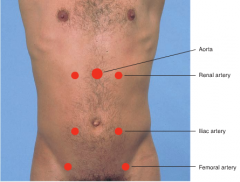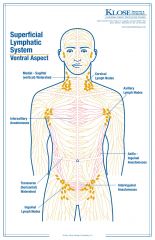![]()
![]()
![]()
Use LEFT and RIGHT arrow keys to navigate between flashcards;
Use UP and DOWN arrow keys to flip the card;
H to show hint;
A reads text to speech;
9 Cards in this Set
- Front
- Back
|
What are the big picture components of the abdominal exam? 3
|
*POSTERIOR.
*ANTERIOR: -LOOK -LISTEN -FEEL |
|
|
What all is involved in the posterior portion of the abdominal exam?
|
**UNDO GOWN IF NECESSARY**
*Use ulnar surface of fist to tap for CVA tenderness at several levels. |
|
|
What all is involved in the LOOK portion of the abdominal exam?
|
**LAY THE PATIENT BACK FLAT. DRAPE THE PATIENT'S LEGS TO THE WAISTBAND AND LIFT GOWN TO EXPOSE THE ABDOMEN.**
1) Look at abdomen. Check for and note scars, striae, weird shapes, pulsations, etc. |
|
|
What all is involved in the LISTEN portion of the abdominal exam?
|

1) Auscultate for bowel sounds.
2) Auscultate for aortic and renal bruits (this pic is from Bates, but we learned to do it lower and a bit off the midline). 3) Percuss all 4 quadrants. 4) Percuss liver span (lifting breast if needed), in the mid-clavicular line. |
|
|
What all is involved in the FEEL portion of the abdominal exam?
|

1) Palpate lightly all 4 quadrants (one hand).
2) Palpate deeply all 4 quadrants (two hands). **LOOK AT THE PATIENT'S FACE DURING THIS** 3) Palpate for liver edge. 4) Palpate for spleen. 5) Palpate for AAA. 6) Palpate femoral pulses and check inguinal lymph nodes. |
|
|
Describe the shifting dullness test:
|
*With patient lying down, percuss for the border of tympany and dullness.
*Have patient roll to LLDP, and percuss for the border again. Note if it changes. *Used to check for fluid. |
|
|
What tests would you do if appendicitis is suspected, and how would you do them?
|
1) Lightly palpate McBurney's point: 2/3 of the way from ASIS to umbilicus.
2) Rovsing sign: In lower left quadrant, press deep and release quickly. Rebound tenderness in lower right quadrant is a positive test. 3) Psoas sign: Put patient on their left side and straighten right leg. Extend right hip backward slowly. It will hurt if it's a positive test. 4) Obturator sign: Patient should be supine. Flex their knee up to their chest, and internally rotate it at the hip. Pain is positive. |
|
|
What test would you do if cholecystitis is suspected, and how would you do it?
|
*Place fingers of right hand under right costal margin and have patient take a deep breath. If the breath is halted due to pain, this is a positive result.
|
|
|
What's the NORMAL oral presentation for the abdominal exam?
|
*ON ABDOMINAL EXAM:
-Abdomen is flat and non-distended, w/o scars or striae. -Normoactive bowel sounds. -No aortic or renal bruits. -Tympanic to percussion throughout. -No pulsatile mass, no HSM. -Soft, non-TTP in all 4 quadrants. -No CVA tenderness. -Femoral pulses are 2+ and symmetric bilaterally. -No Inguinal lymphadenopathy. *BONUS: -No shifting dullness. -No Murphy's sign. -McBurney's point is not TTP. -Negative psoas and obturator signs. -Negative Rosving's sign. |

